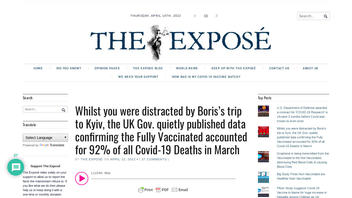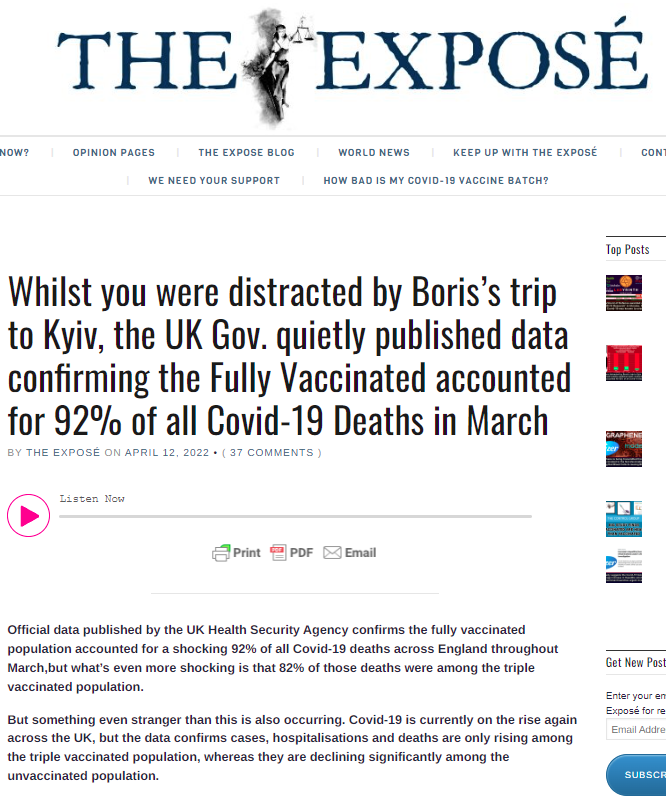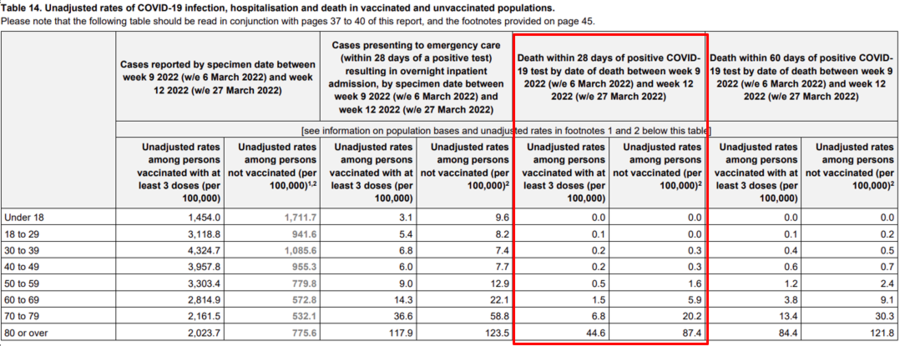
Do fully vaccinated people account for 92 percent of COVID-19 deaths in England? Yes, it's slightly exaggerated but true: However, simple ratio analysis based on that statistic doesn't fully tell the story. The report these figures come from warns on Page 45 that "Comparing case rates among vaccinated and unvaccinated populations should not be used to estimate vaccine effectiveness against COVID-19 infection."
Biostatistics experts have explained in related Lead Stories fact checks that those most likely to be vaccinated in the United Kingdom are the elderly, who are also most at risk of serious illness if they suffer a breakthrough infection. Looking at all COVID deaths -- instead of comparing like-age patients -- muddles the evidence of vaccine effectiveness.
The claim appeared in an article (archived here) published by The Exposé on April 12, 2022, under the title "Whilst you were distracted by Boris's trip to Kyiv, the UK Gov. quietly published data confirming the Fully Vaccinated accounted for 92% of all Covid-19 Deaths in March." It opened:
Official data published by the UK Health Security Agency confirms the fully vaccinated population accounted for a shocking 92% of all Covid-19 deaths across England throughout March,but what's even more shocking is that 82% of those deaths were among the triple vaccinated population.
But something even stranger than this is also occurring. Covid-19 is currently on the rise again across the UK, but the data confirms cases, hospitalisations and deaths are only rising among the triple vaccinated population, whereas they are declining significantly among the unvaccinated population.
This is what the post looked like on The Exposé website on April 14, 2022:
(Source: The Exposé screenshot taken on Thu Apr 14 14:52:16 2022 UTC)
The figures in The Exposé article are largely accurate, but aren't presented in context and ignore an important footnote from the COVID-19 vaccine surveillance report Week 13 from the U.K. Health Security Agency (HSA), published on March 31, 2022. A footnote on Page 44 says:
In the context of very high vaccine coverage in the population, even with a highly effective vaccine, it is expected that a large proportion of cases, hospitalisations and deaths would occur in vaccinated individuals, simply because a larger proportion of the population are vaccinated than unvaccinated and no vaccine is 100% effective. This is especially true because vaccination has been prioritised in individuals who are more susceptible or more at risk of severe disease. Individuals in risk groups may also be more at risk of hospitalisation or death due to non-COVID-19 causes, and thus may be hospitalised or die with COVID-19 rather than because of COVID-19.
An April 14, 2022, email from the UK HSA provided additional context:
It is not because people who are vaccinated are more likely to die, it is because more people are vaccinated than unvaccinated. There will always be some breakthrough infections leading to death because no vaccine is 100% effective, but a small proportion of a very large (vaccinated) population is sometimes bigger than a larger proportion of a smaller (unvaccinated) population.
The population of England was 74.4 percent fully vaccinated as of April 11, 2022, with 118.7 million doses given, according to the U.K. coronavirus website. That compares to 65.7 percent of the total U.S. population being fully vaccinated through April 8, 2022, according to the Centers for Disease Control and Prevention (CDC). Page 4 of the UK vaccine surveillance report says:
Based on antibody testing of blood donors, 99.3% of the adult population have antibodies to COVID-19 from either infection or vaccination compared to 36.0% that have antibodies from infection alone.
Everyone aged 12 and over, and some children aged 5 to 11, can get a first and second dose of the COVID vaccine, according to the U.K. National Health Service. People aged 16 and over, and some children aged 12 to 15, can also get a booster dose.
According to calculations based on HSA COVID reports (Table 13) from the week ending March 6, 2022, through the week ending March 27, 2022, virus-related deaths totaled 2,144 during that timeframe -- 214 (10%) were unvaccinated, 1,930 (90%) were vaccinated. That means nearly 9 in every 10 COVID-19 deaths in England were among those who had received at least one dose of a COVID vaccine (greater than 87% had received two or more shots). It's less than The Exposé's 92% claim, but still a similar number.
The HSA report included the following as part of its key results (Page 38) through March 31, 2022:
The rate of hospitalisation within 28 days of a positive COVID-19 test increases with age, and is substantially greater in unvaccinated individuals compared to vaccinated individuals.
The rate of death within 28 days or within 60 days of a positive COVID-19 test increases with age, and again is substantially greater in unvaccinated individuals compared to fully vaccinated individuals.
Also from the April 14, 2022, email to Lead Stories, the U.K. HSA said:
The important statistic here is the rate of death for each group. Percentage wise, the proportion of deaths remains higher in those who are unvaccinated, compared to those who are vaccinated. Table 14 on page 45 of the report shows the rate of death per 100,000 people, split by age. As you can see, in every age group (barring in this report the very low numbers in the 18-29 age group under the 'deaths within 28-days' column), the rate of death is higher in those who are unvaccinated, compared to those who are vaccinated with at least three doses.
This is the deaths section from Table 14 in the report:
(Source: COVID-19 vaccine surveillance report Week 13 screenshot taken on Thu 14 16:30:10 2022 UTC)
The Executive summary of the report says the safety of COVID vaccines is continuously being monitored by the U.K. Medicines and Healthcare Regulatory Agency:
They conclude that overall, the benefits of COVID-19 vaccines outweigh any potential risks
Earlier Lead Stories fact checks looked at similar claims by The Exposé and found them to be misleading (here, here and here).
















